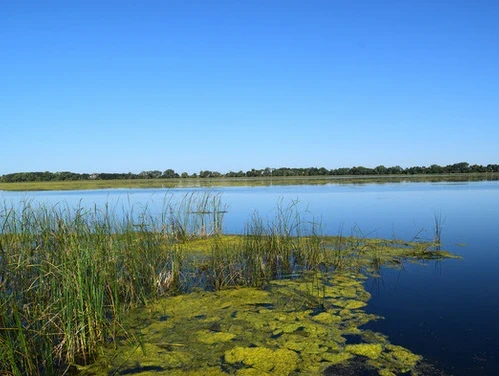West Swan Lake doesn’t much resemble itself from 2019 – before the work began to improve the water quality on the 925-acre shallow lake.
West Swan Lake is part of a string of lakes and marshes stretching through the middle of Emmet County. It sits at the lower end of the chain which makes it difficult to keep carp out because they can enter from multiple locations. The lake also struggled with the lack of aquatic vegetation, which led to turbid water and little use by wildlife.
To manage the lake, the DNR needed the ability to control its water level and to control the rough fish population, primarily common carp.
“The old drawdown structure couldn’t do what we needed it to do, so a new structure was installed to give us drawdown capability,” said Lucas Straw, wildlife biologist with the Iowa Department of Natural Resources (DNR) Prairie Lakes Unit.
A contactor dug a 1,200-foot-long channel to connect the water control structure to the east basin of the lake, which then allowed the DNR to lower the lake level by as much as three feet.
With a maximum depth of 5-1/2 feet, removing three feet of water exposes much of the lakebed where plants take root and grow, which, when refilled, helps to protect water quality by reducing wave action, using up nutrients from the sediment and protecting against shoreline erosion.
The combination of revegetation and carp removal produced impressive results when the lake refilled.
“We have super clear water. Thousands of pintails were here last fall. Swans were using the lake during and post renovation. Duck hunting has been really good, and fishing will be really good next year,” Straw said.
Getting the lake to this point took a few years.
Beginning in 2021, the DNR hosted local public meetings to discuss the project and gain public support. “We had a lot to local partnerships, support from the local sportsman. A lot of local meeting were held to keep everyone up to speed on the project,” Straw said. “Neighboring landowners were an important partner, providing a place for the silt to be deposited and allowing lake access to staff to check water levels and calculate chemical application rates and treat remote wetlands and field tiles.”
One of the more challenging aspects of the project was eliminating the invasive carp population.
Unfortunately, when it came to killing carp, Mother Nature didn’t cooperate. Mild winters, untimely rain hampered efforts to renovate the fishery.
The third attempt incorporated a new practice using drones to apply the chemical over two days in October 2024 that was successful. “It’s the first time, as far as we’re aware, that a drone was used for this process,” Straw said.
The connected marshes, waterways and field tile were treated by local staff using hand sprayers.
The lake has been restocked with yellow perch, northern pike, largemouth bass and bluegills.
While the lake was down, a contractor installed a rock dam on the channel connecting East Slough to Ingham Lake, which is intended to prevent fish passage. The innovative rock dam design, using the old road bed for its foundation, allows staff to bring in an excavator to clean the rock and facilitate good water movement.
With vegetation returning, the lake can host a number of hunters, which helps to keep birds moving which can make hunting better. It has also made West Swan Lake a good place to paddle.
